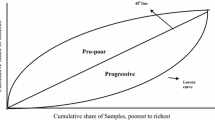Abstract
This paper explores the issue of how a country for which the prioritization of public spending towards poverty reduction is a key policy concern can monitor the distributional effects of public spending. Employing standard benefit-incidence analysis, this paper empirically examines how public education spending is currently distributed in Yemen. It also considers the extent to which the distributional benefit to the poor should and can be improved, focusing on possible changes in cost sharing for higher education and on associated changes in budget allocations. The findings support the government’s decision to increase cost sharing while maintaining a high overall level of public education spending and provide a benchmark from which to monitor the impact of this and other education spending decisions on the poor.
Similar content being viewed by others
References
Asian Development Bank. (2002).Policy on education. Manila: Asian Development Bank.
Bray, M. (2000). Financing higher education in Asia: Patterns, trends and options’, prospects.Quarterly Review of Comparative Education, 30(3), 331–348.
Bray, M. (2002). The costs and financing of education: Trends and policy implications.Education in developing Asia. Manila: Asian Development Bank & Hong Kong: Comparative Education Research Centre, The University of Hong Kong.
Castro-Leal, F. (1996a). Who benefits from public education spending in Malawi: Results from the recent education reform. Washington DC: World Bank.
Castro-Leal, F. (1996b). Poverty and inequality in the distribution of public education spending in South Africa. Washington DC: World Bank.
Castro-Leal, F., Dayton, D., Demery, L., & Mehra, K. (1999). Public social spending in Africa: Do the poor benefit.The World Bank Research Observer, 14, 49–72.
Crouch, L. A. (1996). Public education equity and efficiency in South Africa: Lessons for other countries.Economics Of Education Review, 15, 125–137
Demery, L. (2000). Benefit incidence: A practitioner’s guide. Washington DC: World Bank.
Demery, L., Chao, S., Bernier, R., & Mehra, K. (1995). The incidence of social spending in Ghana. Washington DC: World Bank.
Hansen, W.L. & Weisbrod, B.A. (1969).Benefits, costs and finance of public higher education. Chicago: Markham.
International Monetary Fund. (2001). Country report republic of Yemen: Selected issues. Washington DC: International Monetary Fund.
Jallade, J. (1974).Public expenditures on education and income distribution in Colombia. Baltimore MD: Johns Hopkins University Press.
Lipton, M., & Ravallion, M. (1995). Poverty and policy. In J. Behrman & T. N. Srinivansan (Eds.),Handbook of development economics (3rd ed.) (pp. 2551–2657). North-Holland, Amsterdam.
Meerman, J. (1979).Public expenditures in Malaysia: Who benefits and why? New York: Oxford University Press
Republic of Yemen. (1999a).Statistical yearbook 1998. Sana’a: Central Statistical Organization.
Republic of Yemen. (1999b).Summary of final results Household Budget Survey 1998. Sana’a: Central Statistical Organization.
Republic of Yemen. (2000).Statistical yearbook 1999. Sana’a: Central Statistical Organization.
Republic of Yemen. (2002a). Draft national strategy for development of basic education in Yemen. First National Basic Education Conference, Sana’a October 26–29, 2002. Sana’a: Ministry of Education.
Republic of Yemen. (2002b). Poverty reduction strategy paper 2003-2005.
Selowsky, M. (1979).Who benefits from government expenditure: A case study of Colombia. New York: Oxford University Press.
Tesliuc, C., & Pop, L. (2000). Poverty, inequality and social protection. In C. Ruhl & D. Daianu (Eds.),Economic transition in Romania: Past, present and future. Retrieved October 1, 2002, from http://www.cerope.ro/ seczone/18wp.ASP.
UNESCO. (2000).World education report. Paris: UNESCO.
World Bank. (1994).Colombia poverty assessment report. Washington DC; World Bank.
World Bank. (1995a).Kenya poverty assessment. Washington DC: World Bank.
World Bank. (1995b).Lao PDR social development assessment and strategy. Washington DC: World Bank.
World Bank. (1996a).Bangladesh Public Expenditure Review. Washington DC: World Bank.
World Bank. (1996b).Madagascar poverty assessment. Washington DC: World Bank.
World Bank. (1999a).Education sector strategy. Washington: World Bank.
World Bank. (1999b).Former Yugoslav Republic of Macedonia focusing on the poor. Washington DC: World Bank.
World Bank. (1999c).Tanzania: Social Sector Review. Washington DC: World Bank.
World Bank. (2000a).World development report 2000/2001. New York: Oxford.
World Bank. (2000b).Making transitional work for everyone poverty and inequality in Europe and Central Asia. Washington DC: World Bank.
World Bank. (2000c).Viet Nam managing public resources better: Public expenditure review 2000. Washington DC: World Bank.
World Bank. (2000d).Ecuador: crisis, poverty and social services. Washington, DC: World Bank.
World Bank. (2000e).Project appraisal document: Yemen basic education expansion project. Washington DC: World Bank.
World Bank. (2001a).Kingdom of Morocco poverty update. Washington DC: World Bank.
World Bank. (2001b).Peruvian education at a crossroads challenges and opportunities for the 21 st century. Washington DC: World Bank.
World Bank. (2002).Republic of Yemen poverty update. Washington DC: World Bank.
Younger, S. (2003). Benefits on the margin: Observations on marginal benefit incidence.The World Bank Economic Review, 17(1), 89–106.
Yuki, T. (in press). Distribution of public education spending in developing countries.The Japanese Journal of Evaluation Studies,3(2).
Author information
Authors and Affiliations
Corresponding author
Rights and permissions
About this article
Cite this article
Yuki, T. Distribution of public education spending for the poor: The case of yemen. Asia Pacific Educ. Rev. 4, 129–139 (2003). https://doi.org/10.1007/BF03025355
Received:
Revised:
Accepted:
Issue Date:
DOI: https://doi.org/10.1007/BF03025355




